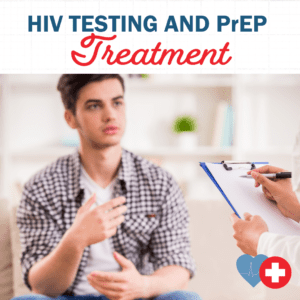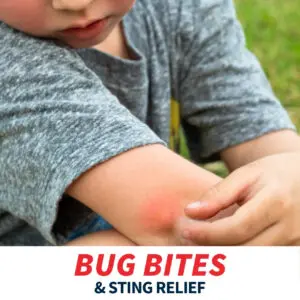HIV Testing and PrEP Treatment for Prevention
 HIV is a very serious infection that, if left undiagnosed and untreated, can develop into AIDS. According to the Centers for Disease Control and Prevention, roughly 1.2 million people in the United States have HIV, and about 158,500 are unaware of their status, leading to nearly 40% of new infections being transmitted unknowingly. It’s recommended that everyone between ages 13 and 64 get tested for HIV at least once just as part of routine wellness checks. But for those with specific risk factors, testing should be done at least once a year.
HIV is a very serious infection that, if left undiagnosed and untreated, can develop into AIDS. According to the Centers for Disease Control and Prevention, roughly 1.2 million people in the United States have HIV, and about 158,500 are unaware of their status, leading to nearly 40% of new infections being transmitted unknowingly. It’s recommended that everyone between ages 13 and 64 get tested for HIV at least once just as part of routine wellness checks. But for those with specific risk factors, testing should be done at least once a year.
Risk factors for HIV
Prior to having sex for the first time with a new partner, it’s always a good idea to discuss your sexual and drug-use history, as well as current HIV status. If possible, you should both consider getting tested to ensure you are safe from infection. Although anyone can contract HIV, there are certain risk factors that may increase your chance of infection. If it’s been over a year since you’ve tested negative for HIV and you can answer “yes” to any of the following, you should get tested again as soon as possible:
- You are a male who has had sex with another male
- You have had anal or vaginal sex with a partner who is HIV-positive
- You have had more than one sexual partner since your previous HIV test
- You have injected drugs and shared needles, syringes or other drug injection equipment with others
- You have had sex in exchange for drugs or money
- You have been diagnosed or treated for another sexually transmitted disease
- You have been diagnosed or treated for hepatitis or tuberculosis
- You have had sex with a partner who was able to answer “yes” to any of the above, or you are unsure of their sexual history
Yearly testing is recommended for any individuals who participate in the above, although some may require more frequent testing. If you are unsure of how often you should be tested for HIV, discuss your risk factors with your medical provider to determine an ideal testing schedule.
Types of HIV tests
When testing for HIV, it’s important to have it done by a professional medical provider. Should you test positive, knowing your status can help you prevent potentially passing the infection to others and get medication to remain healthy for many years. There are a variety of tests your physician may perform, all of which are very accurate. Some tests can detect HIV soon after infection, but no test can detect the virus immediately after infection.
- Antibody tests: These tests look for antibodies to HIV within the blood or oral fluid. Generally, those performed using withdrawn blood from a vein can detect HIV sooner than those that use a finger stick or oral fluid. Depending on the test used, antibody tests can detect HIV infection 23 to 90 days after exposure.
- Antigen/antibody tests: In addition to antibodies, these also look for HIV antigens that the body’s immune system produces prior to antibodies. This particular type of test is performed via lab using blood drawn from a vein. When performed via blood draw, the antigen/antibody test can detect HIV infection 18 to 45 days after exposure.
- NAT: The NAT looks for the presence of the actual virus within the blood. These are typically used for those who have been exposed recently or are experiencing early HIV symptoms but have tested negative with one of the other testing methods. NATs can detect HIV infection 10 to 33 days after exposure.
If you tested using a rapid or self-test and received a positive result, visit your medical provider as soon as possible for a lab test to confirm your result. Should you be HIV-positive, unfortunately it cannot be cured. However, your doctor can prescribe medication that can lower the viral load, helping you prevent spreading the infection to others as well as keeping you healthy for many years.
PrEP treatment for HIV-infection prevention
For those who are HIV-negative but may be at higher risk of exposure, there is medication that can be taken as a preventive. PrEP, or pre-exposure prophylaxis, is about 99% effective at preventing HIV from sex and at least 74% effective at preventing HIV from drug injections when taken as prescribed. Your risk factors will determine whether pills or shots will be more effective for prevention. The medication can take anywhere from seven to 21 days of daily use to reach full effectiveness dependent upon the type of exposure. PrEP is ideal for individuals who are HIV-negative and:
- Have a sexual partner who is HIV-positive with an unknown or detectable viral load
- Inconsistently use a condom during sexual activity
- Have been diagnosed with a sexually transmitted disease within the past six months
- Inject drugs and have a partner who is HIV-positive
- Inject drugs and share needles, syringes or other injection equipment
- Have previously been prescribed PEP, or post-exposure prophylaxis, and report continued risk behavior
- Have used multiple courses of PEP
Even if the above behaviors do not apply to you, it is still possible you can take PrEP. Talk with your physician about your concerns and potential exposure risks to determine if you may benefit from regularly taking PrEP.
Knowing your HIV status is essential for your overall health as well as protecting your partners. At Midwest Express Clinic, we offer discreet, convenient testing when you need it. Whether you have recently been exposed to HIV, have an increased risk due to certain behaviors or you are due for a routine screening, stop in to one of our convenient area locations today. Before stopping in, use our fast, easy online check-in to minimize your wait time at the office.




